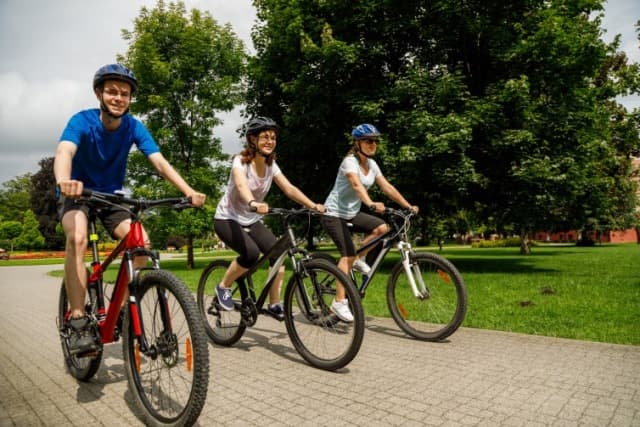Bike Safety Facts and Fiction
3.9.2018 | Guest Author

For many children and teens, biking in the driveway, around the neighborhood, or to a nearby school or park provides a sense of freedom and adventure.
Not only can biking be fun, it can also be beneficial to a child’s physical health — strengthening their heart, lungs, muscles and bones — as well as mental health, supporting learning and development.
With activities like biking, it’s always important to practice safety. However, with so many different resources available for families, it can be difficult to decide what bike safety practices are reliable and effective to teach their children.
Dr. Cora Breuner, a pediatrician and adolescent medicine specialist at Seattle Children’s, separates facts from fiction when it comes to bike safety, and shares tips from the dynamic perspective of a provider, educator and parent.
Figuring out the facts
Fiction: I don’t need to talk to my child about bike safety since I was never injured as a child.
Fact: While biking can be fun, it doesn’t come without risks. Each year, thousands of kids are treated in emergency departments due to bicycle-related traumatic brain injuries (TBI). TBI is defined as a disruption in the normal function of the brain that can be caused by a bump, blow or jolt to the head, or penetrating head injury. Everyone is at risk for TBI, especially children. Fortunately, wearing a bike helmet can lower the risk of head injuries. If an accident does occur, throw away the helmet and get a new one. It’s important to talk to your child about bike safety — don’t rely on pure luck to keep them safe.
Fiction: My child doesn’t need to wear a helmet during short-distance rides.
Fact: Bike accidents can happen anywhere. Many bike accidents happen near homes, in driveways, or on sidewalks or bike paths. Make it a habit to wear a bike helmet for every ride. Think of it like choosing to wear a seat belt during each car ride. Many cities and counties in Washington State require helmet use with bicycles at all times.
Fiction: It’s okay for my child to wear a bike helmet that’s a little too big or small.
Fact: Bike helmets provide the best protection when they fit correctly. A properly fitted bike helmet should be low and level on the forehead. The straps should be even and form a “Y” under each earlobe, and the buckled chin strap needs to be snug with room to insert just a finger between the buckle and chin.
Fiction: It’s safe to wear another type of helmet (e.g., football or skateboarding helmet) while biking.
Fact: All helmets are not the same. Other types of helmets, such as ones for football or skateboarding, are not designed to protect against impacts caused by bicycle accidents. Only use a helmet designed for biking. To be sure you choose the best helmet for your child, look for a Consumer Product Safety Commission (CPSC), Snell, American Society for Testing and Materials (ASTM) or American National Standards Institute (ANSI) sticker inside a helmet. This sticker will confirm that the helmet meets mandatory federal safety standards. Encouraging your child to pick out their own helmet may make them more likely to wear it. Always try on a helmet before purchasing to make sure it is the right fit.
Fiction: My child should ride facing traffic to be safer.
Fact: Always ride on the right of the road, in the same direction as traffic. Bicycle-car collisions do occur from bicyclists riding against traffic. It may seem like it is safer to see oncoming traffic while riding against traffic, but this can confuse and surprise drivers. It is important to ride with the flow of traffic, use hand signals and obey all traffic signs. It is best to walk bikes across streets and intersections. Teach kids to make eye contact with drivers when crossing the street to be sure they are seen.
Fiction: I only need to talk to my child about practicing bike safety when they’re young.
Fact: Bike safety practices advance as children develop, and as you give them increasing freedom to ride farther. Many young children do not have fully developed eye-hand coordination yet, and may not recognize obstacles as quickly as teens and adults. Additionally, it may be more difficult for kids to judge speed and distance of cars until they reach the age of 10. In middle childhood and early adolescence, children’s skill levels tend to increase, but so do their risk-taking behaviors.
Families who ride bikes together, practice bike safety together
Modeling safe behavior is key in encouraging your children to follow suit. Research has found that if parents wear a helmet, their children are more likely to wear a helmet too. The same goes for all bike safety behaviors. Practicing safety together can help your child develop habits that will protect their growing body and mind.
Seattle Children’s is continuing its commitment to bike safety through the Kohl’s Helmet Safety Program. In partnership with Kohl’s Cares, we’re traveling around Washington State to provide free helmet fittings and giveaways for children. We teach parents and kids how to properly fit every helmet we give away, but we don’t stop there. We also provide resources to teach you to fit helmets where you are, in the community or at home. In our eight-year partnership, we have properly fit and given away over 25,000 helmets.
Our free bike helmet fitting and giveaways begin March through September 2018. Helmets are available for children 1 to 18 years old.
Resources:
- Safe Travel Tips for Active Families on the Go
- KidsHealth: Bike Safety
- Safe Kids Worldwide: Bike Safety Tips
- U.S. Consumer Product Safety Commission: Which Helmet for Which Activity?